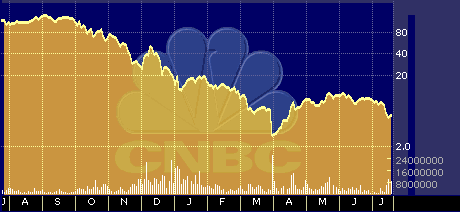
CacheFlow Latest Red-Hot Net IPO
by Hal Plotkin
Silicon Valley Correspondent
CacheFlow’s products help the Internet run faster by speeding up the delivery of Web pages to users. But investors and analysts’ speedy hopes for CacheFlow {CFLO} stock were exceeded today, when its shares opened at $110.
Its initial public offering of 5.5 million shares priced last night at a strong $24 a share, up from the company’s stated range of $18 to $20.
Analysts had expected CacheFlow’s stock to perform well, even though the Internet caching-appliances company will face growing competition in the future.
“I like the guys at CacheFlow,” says Carl Howe, research director at Forrester Research, based in Cambridge, Mass. “They come out of Network Appliance. They know that if they can make devices more application-specific, they can be optimized for certain markets. It’s a good strategy. My guess is CacheFlow will be successful as an IPO.”
Founded in 1996, the Sunnyvale, Calif., company’s products enable Internet service providers and other telecommunications or Internet-based companies to store frequently accessed Web pages on servers located closer to end users. The technology dramatically speeds up the time it takes for Web pages to be delivered to their destinations.
On average, it takes between 15 and 45 seconds for an average Web page to be delivered after it has been requested by an Internet user in the United States. Latency delays are frequently much longer for Web surfers outside the U.S.
A number of factors are responsible for the delays, including the distance of users from the server that contains the data they want and the number of users simultaneously competing to have the same Web pages delivered to their computers.
“Caching addresses both problems,” says Pu Xiang, a senior analyst at Dataquest, based in San Jose, Calif., who adds that caching appliances are proving popular with ISPs. “There are so many ISPs out there. Anything that lets them make the experience better for their customers creates a significant competitive advantage for them.”
What’s more, Xiang says, the problems addressed by caching are only expected to worsen as the avalanche of data accessible over the Internet increases.
Overall, the total market for caching appliances is expected to increase to $3.3 billion by 2003 from $135 million in 1999, according to Dataquest.
The burgeoning market provides CacheFlow with its biggest opportunity and its biggest challenge.
“As the market grows larger, I expect to see bigger players jumping into it even more aggressively,” Xiang says. “As a result, the market is likely to become commoditized over time.”
Xiang says the only way caching companies such as CacheFlow will be able to compete will be to increase the performance of their products as prices come down. “If the market is proven, it’s going to become very competitive,” he adds.
There is, however, at least one reason to be optimistic about the competitiveness of CacheFlow’s products. In a comparative study of caching appliances, PC Magazine selected the $10,000 CacheFlow 500 as its “editors’ pick” over similar caching products produced by better-known rivals, such as Compaq Computer Corp. {CPQ} and Dell Computer Corp. {DELL}
The magazine cited CacheFlow 500’s ease of installation, high-end performance, and superior document-management tools in making its pick. CacheFlow’s “software far exceeds the competition in terms of ease of use, detail, and graphical representation,” wrote PC Magazine’s Jeffrey G. Witt.
On the high-end, however, CacheFlow faces a raft of competitors focused on serving larger customers, such as America Online Inc. {AOL}, Excite@Home {ATHM}, and Yahoo!, which require more-powerful caching solutions. Competitors in the higher-end market include Cisco Systems Inc. {CSCO}, InfoLibria, Inktomi Corp. {INKT}, Lucent Technologies Inc. {LU}, Network Appliance Inc. {NTAP}, both of which have recently entered the market.
“The 800 lb. gorilla in caching right now is Inktomi,” says Howe of Forrester Research.
Last month, Foster City, Calif.-based Inktomi reported 1999 fiscal year-end revenue of $71.2 million, a 248 percent increase over revenue of $20.4 million during the prior fiscal year. Inktomi posted a $24.2 million loss in 1999, compared with a loss of $24.5 million in 1998.

INKT 52-week stock performance chart
Unlike CacheFlow’s hardware appliances, Inktomi’s most popular high-end caching solution, called Traffic Server, is a $24,000 software product that can run on any general-purpose server.
Howe says CacheFlow was smart to focus on serving smaller ISPs with dedicated hardware that’s easy to install. However, he says CacheFlow “will have a very tough fight” as it tries to compete with the likes of Inktomi and relative newcomers Cisco and Lucent, when it comes to wooing customers with larger caching needs.
What’s more, Howe says he isn’t convinced the Dataquest market projection of $3.3 billion in caching appliance sales by 2003 will prove accurate. Howe notes that newer Web-page technologies, such as personalized Web pages, are already making caching less useful.
“Whether it’s myYahoo.com or finance sites, personalizing information on Web pages is becoming more and more important,” Howe says. “That presents a problem for caching companies, since no one else is ever going to want the same exact same personalized Web page you want. So caching, in some respects, becomes less-important.”
However, Howe notes that since most data on the Internet now originates in the U.S., companies located outside the U.S. can achieve substantial cost savings by caching at least some data on local servers.
“A T-3 [high capacity] data line across the Pacific costs $1 million a month,” Howe says. “Anything that can cut down on telecommunications costs in those markets will be welcome.”
CacheFlow lost $13.2 million on sales of $7.03 million for the fiscal year ended April 30, compared with a loss of $5.5 million on zero sales in fiscal 1998.


